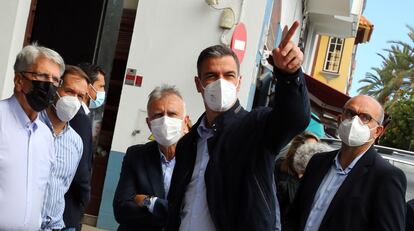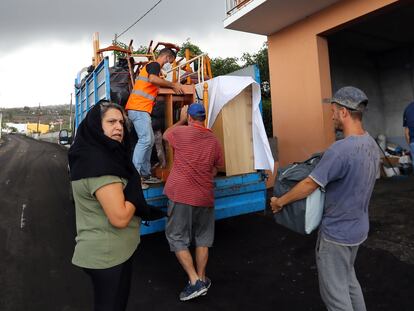La Palma hit by largest earthquake since eruption began, while lava forces more evacuations
Spanish Prime Minister Pedro Sánchez has called for “patience” and warned that the situation is likely to continue for some time

The Canary Island of La Palma was hit on Wednesday by an earthquake measuring 4.5 on the Richter scale, making it the largest detected in the region since the eruption of the new volcano began on September 19. According to Spain’s National Geographic Institute (IGN), the quake was recorded at a depth of 37 kilometers at around 1am, and was felt by residents on the island. It was one of more than 50 tremors to hit La Palma during the early hours of Wednesday.
The earthquake was recorded just hours after another neighborhood on La Palma was forced to evacuate due to the advance of a lava tongue. The decision affected around 15 residents in an area of Los Llanos de Aridane, who were given until midnight to take everything they could – including their pets – from their homes, and travel to a meeting point at Campo de Lucha Camino León in Los Llanos de Aridane.
The evacuees were also instructed to take their identification documents with them, any medication they require, as well as their cellphones, chargers, flashlights and several changes of clothes. They were likely to be moved to the military barracks at El Fuerte, on the outskirts of Santa Cruz de La Palma. They were also advised to lower their window blinds and close all doors before leaving, as well as turning off supplies of water, gas and electricity.
The volcanic eruption on La Palma – part of the Spanish archipelago located off the northwestern coast of Africa – has created at least three tongues of lava. The first has reached the Atlantic Ocean, via Montaña de Todoque, a mountain in the neighborhood of the same name. According to Miguel Ángel Morcuende, the spokesperson of Volcano Risk Prevention Plan (Pevolca), this flow has “lost energy.” The second is moving parallel to the first but is not considered a security risk as the at-risk areas have been evacuated. This flow is currently 200 meters from the sea. When it reaches the Atlantic Ocean, it could create a new lava platform.
A live feed of the eruption on La Palma.
The third tongue, located northeast of the main flow, is the one that triggered last night’s evacuations. Up to 800 people were also forced to leave their homes earlier on Wednesday due to the advance of this lava tongue. At the weekend, this flow reached an industrial area called Callejón de La Gata, which led authorities to order the residents of several neighborhoods to stay in their homes due to the risk of toxic gases.
Earlier on Wednesday, Spanish Prime Minister Pedro Sánchez made his fourth visit to La Palma since the eruption of the new volcano in Cumbre Vieja nature park. At a press conference, the Socialist Party (PSOE) leader said local, regional and central authorities were “working around the clock” to help the island. “We all have a common objective, that is to save lives [...], rehouse people and take on the work of rebuilding,” he said, explaining that the most pressing task was “rehousing the people who are at risk of losing their homes or have already lost everything.”

“We have a lot of work ahead of us,” he said. “The volcanic activity is not stopping and it does not appear that we are going to see a reduction in the next few days.”
“I have something very difficult to ask of the people of La Palma,” he continued. “Patience, because we can’t do anything until the volcanic activity stops.”
Ángel Víctor Torres, the premier of the Canary Islands, who also appeared at the press conference, added: “We are at the mercy of this volcano. It will tell us when it is over.”
So far, there are no signs that the eruption is coming to an end. Pevolca spokesperson María José Blanco explained on Wednesday that the volcano was currently emitting more than 17,000 tons of sulfur dioxide a day. For the eruption to be considered to be easing, “this figure must fall to below 100 tons a day,” she said.
The lava from the new volcano now covers close to 8% of the surface area of La Palma. According to data released on Wednesday by the European observation system Copernicus, the lava has affected 656 hectares of land and has destroyed 1,458 buildings.
Recovery effort
At Wednesday’s press conference, Sánchez reminded the public of the measures the government has introduced to help La Palma recover from the impact of the eruption. It has approved €10 million in urgent aid to buy homes and basic necessities, declared the area a disaster zone (officially classified as a zone severely affected by a civil protection emergency) and passed a comprehensive aid scheme via royal decree that is valued at €214 million.
Tu suscripción se está usando en otro dispositivo
¿Quieres añadir otro usuario a tu suscripción?
Si continúas leyendo en este dispositivo, no se podrá leer en el otro.
FlechaTu suscripción se está usando en otro dispositivo y solo puedes acceder a EL PAÍS desde un dispositivo a la vez.
Si quieres compartir tu cuenta, cambia tu suscripción a la modalidad Premium, así podrás añadir otro usuario. Cada uno accederá con su propia cuenta de email, lo que os permitirá personalizar vuestra experiencia en EL PAÍS.
¿Tienes una suscripción de empresa? Accede aquí para contratar más cuentas.
En el caso de no saber quién está usando tu cuenta, te recomendamos cambiar tu contraseña aquí.
Si decides continuar compartiendo tu cuenta, este mensaje se mostrará en tu dispositivo y en el de la otra persona que está usando tu cuenta de forma indefinida, afectando a tu experiencia de lectura. Puedes consultar aquí los términos y condiciones de la suscripción digital.
More information

As many as 800 more residents evacuated in La Palma as lava from volcano approaches
Últimas noticias
Most viewed
- Reinhard Genzel, Nobel laureate in physics: ‘One-minute videos will never give you the truth’
- Oona Chaplin: ‘I told James Cameron that I was living in a treehouse and starting a permaculture project with a friend’
- Pablo Escobar’s hippos: A serious environmental problem, 40 years on
- Why we lost the habit of sleeping in two segments and how that changed our sense of time
- Chevy Chase, the beloved comedian who was a monster off camera: ‘Not everyone hated him, just the people who’ve worked with him’










































